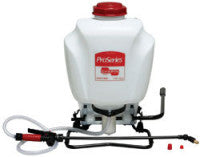Calibrating a Sprayer
The single most asked question in pesticide application is: "How much do I put in a knapsack?"
The answer is that it dep
It is important that the correct amount of pesticide is applied per square metre, the amount of water much less so.
As every sprayer has a different capacity, different nozzles with higher or lower output, a different operator who works at a different speed and pumps at a higher or lower pressure, calibration is the only answer. Here is one simple way to do it:
1. Measure exactly one litre of water into an empty sprayer and prepare it for spraying.
2. On a dry hard surface where you can see the spray wet it, walk forward, continually spraying as you would normally operate until the sprayer is empty. Measure how many square metres you have covered. Let us assume that this might be for instance, 20 square metres.
3. If your sprayer is a 15 litre model you multiply its normal capacity (15) x 20 (area one litre covered) = 300 square metres. This is the area that a whole knapsack will treat.
4. To work out how much pesticide to measure into the sprayer is now very easy. Look at the application rate on the product label.
eg. Roundup ProBiactive is 5L (=5,000ml) per Hectare (10,000 sq. metres)
5. To calculate how much to measure into your sprayer:
For example: 300 (Area that one sprayer full will cover) x 5,000 (Pesticide application rate per hectare in millilitres) / 10,000 (One hectare in square metres) = 150 millilitres
There is a selection of Sprayers in the Pitchcare Shop.
